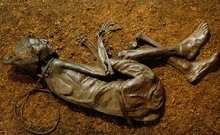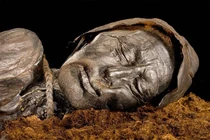On 6 May 1950, two brothers were cutting pea in the Bjaeldskov bog, when they came upon a body that was so well preserved, thought it was a recent death. Upon closer examination, it was realized that the body was actually a amazingly preserved man from 4th century BC. Now known as Tollund Man, he lived in what is now Silkeborg, Denmark. minute details such as eyelashes, chin stubble, skin, and wrinkles have survived. Tollund man was thought to be around 40 years of age at his time of death, at a height of over 5 feet tall.
It is thought that the Tollund man was a sacrifice, then was placed in a peat bog which preserved him.
Mummification[]
The Tollund Man was naturally mummified in a peat bog, making him a "bog body". Bog bodies have their skin and internal organs preserved extremely well due to the conditions in the bogs. Theses conditions include low temperatures, lack of oxygen and very acidic water (pH of 3-5). The highly acidic water helps preserve the skin but it also dissolves calcium phosphate (which is found in human bones) [1].
The head was well preserved, his hair was short (1-2 centimeters long) and he had partly preserved eyebrows. On his upper lip, chin and cheeks appeared very short but thick stubble. His eyes, mouth and well-preserved lips were closed.

The upper part of his body was bent slightly forward and most of the skin had been preserved. However, the left side of his chest and shoulder was somewhat decomposed. The right side of the body was well-preserved. Down his back was a long line of sharp cuts caused by the spades that dug into him when he was discovered in the bog. His hip socket had pierced the skin on his left side. The skin of the stomach was pleated. The genitals were well-preserved and that of a male.
On one of the soles of his feet medical examiners found two scars which proved that tended to go barefoot and several times have stepped on sharp stones or thorns. The fact that the toes are slightly pushed together might indicate that he did wear some kind of footwear at other times.
Studies[]
It was clear that he had been hanged, but archaeologists were unsure why. After an investigation, it was noted that the Tollund Man's eyes and mouth had been carefully closed, something that wouldn't have happened if he had been hanged as punishment for a crime. Also, during that time period, everyone who died in Denmark was cremated, except for those that were sacrificed. It was therefore concluded, that he had been hanged as a human sacrifice [2].
His body was arranged in the fetal position, and after being examined, scientists found a animal hide rope around his neck as well as bruising on the skin under his chin. He was found wearing a sheepskin cap and a wide belt.
His last meal was porridge made from over 40 different kinds of grains and seeds.
Pathology[]
The Tollund Man died from asphyxia by hanging. The forensic examiner’s report stated “the rope, judging by the way it was paced around the body’s neck, was most likely not used for strangulation, and because of that it is of less importance that the cervical vertebras were undamaged since that sometimes happens when a person is hanged”. X-rays revealed the Tollund Man’s cervical vertebrae were not broken despite the evidence that he had been hanged.
Additional[]
When the Tollund Man was discovered in 1950, the two men that found the mummy thought that it was a recent murder victim because of how well preserved the body was. They alerted the local police of their findings, but they soon realized the body was much older than originally thought and called for Professor P.V. Glob, who determined that they had actually just unearthed an ancient burial [1].
The Tollund Man was found completely naked, except for a narrow leather belt made of oxhide around his waist.
His head was covered with a leather cap made of sheepskin (eight pieces with the fur turned inwards). The pieces were sown together with thread (most likely wool).
External Links[]
Silkeborg Museum. (2004). The Tollunad man: A face of pre-historic Denmark. Retrieved from http://www.tollundman.dk/et-lig-dukker-op.asp
http://www.tollundman.dk/liget.asp
References[]
1. The Tollund Man - A Face from Prehistoric Denmark. (2005). Retrieved October 12, 2015, from http://www.tollundman.dk/
2. Holloway, A. (2014, March 5). Tollund Man – the preserved face from Prehistoric Denmark and the tale of ritual sacrifice. Retrieved October 12, 2015, from http://www.ancient-origins.net/ancient-places-europe/tollund-man-preserved-face-prehistoric-denmark-and-tale-ritual-098888
The Tollund Man's Appearance. (n.d.). Retrieved November 19, 2017, from http://www.tollundman.dk/udseende.asp
Lewis, S. K. (2006, February 07). Tollund Man. Retrieved November 19, 2017, from http://www.pbs.org/wgbh/nova/ancient/tolland-man.html
Tollund Man. (2010, October 28). Retrieved November 19, 2017, from https://www.atlasobscura.com/places/tollund-man
Welcome to the story about Tollund Man. (n.d.). Retrieved November 19, 2017, from http://www.museumsilkeborg.dk/Welcome_to_the_story_about_Tollund_Man
